In our globalized world, translation seems to be everywhere. In subtitles, instructions, signs, menus, in meetings, and walking down the street. And recently, in fiction too. The representation of the act of translation and the task of the translator has become a recurrent topic in literature. In English, novels such as Idra Novey’s Ways to Disappear and Rachel Cantor’s Good on Paper, both from 2016 and with translator protagonists, were very well received by readers as well as critics; and the latest anthology Crossing Borders, edited by Lynne Sharon Schwartz, brings together stories on translation and translators by acclaimed writers such as Joyce Carol Oates and Lydia Davis, among others. Translation was even at the center of the Academy Award nominee film Arrival (based on Ted Chiang’s short story “Story of Your Life”) in which Golden Globe nominee Amy Adams plays a translator tasked with communicating with heptapod aliens. The increasing need to understand the importance of translation in our globalized world has manifested in a recurrence with which works of fiction feature a translator or interpreter as the main character. In Spanish, too, there have been dozens of novels with translator protagonists written in the last few decades by both mainstream and cult authors, and by both translators who write and writers who translate. With this newly found interest in translation, more and more of these novels are being translated into English. Here are five novels on translators originally written in Spanish that are available to read in English translation.
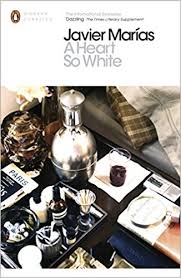
A Heart So White by Javier Marías (The Harvill Press, 1995 / Penguin Books, 2012), translated by Margaret Jull Costa
Arguably one of his best novels, labeled a masterpiece by more than one critic, Spanish author Javier Marías’s Corazón tan blanco (Anagrama, 1992) is an intrigue novel about family secrets and the mysteries behind the institution of marriage. An unnamed interpreter is living the good international life, dividing his time between European and New Yorker diplomatic meetings and multilingual congresses, a lifestyle that competes with his status as newlywed in Madrid, where his wife Luisa, also a translator, is trying to build a life for them. This is also a novel about miscommunication, echoes and silences. Hovering throughout the pages are unnerving repetitions and an eerie feeling that accompanies readers throughout the narrative of this translator turned reluctant detective, as he can’t help but decipher how the failed marriages of his father (which includes the suicide of his first wife) are tampering with his own incipient matrimony. Finally, the novel is also about translation too, or rather, about mistranslation. In one of my favorite scenes, incidentally where the protagonist and his future wife Luisa meet, the protagonist is interpreting in a meeting between a Spanish and an English mandatary. Out of bored malice, the interpreter completely changes their words and creates an alternative conversation in translation where these bastions of democracy end up admitting to their authoritarian desires, revealing their true inner selves. The scene is hysterical as it stretches the limit of what could be acceptable from an interpreter and showcases the power of mistranslation, of what happens when one purposefully betrays the original.
The theme of treachery, both in marriage and in translation, becomes evident too in the Shakespearean intertextuality of the novel’s title, which alludes to Lady Macbeth’s parliament to her husband after Duncan’s murder: “My hands are of your colour; but I shame to wear a heart so white.” The interpreter protagonist ponders the different meanings and potential readings of the deceivingly simple yet highly polysemic word “white,” which can evoke images of purity, innocence, guiltlessness, virginity.
Translation is not only a fictional theme and rhetorical tool for Marías, also a translator himself. Having translated most notably Conrad, Sterne, and Hardy, among others, translation for Marías is a way of reading and writing. His translations have informed his work and a lot of his references come from English, making the shift in language of his novels seamless. This in no way undermines the amazing work of Margaret Jull Costa, who has translated a dozen of Marías’s novels and whose translation of A Heart So White earned the International IMPAC Dublin Literary Award for best novel published in English in 1997. “I’m attracted to writers who are as interested in how they say something as in what they are saying, writers who have a superb grasp of their own language,” she said in an interview.
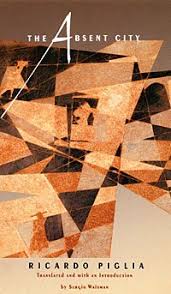
The Absent City by Ricardo Piglia (Duke University Press, 2000), translated by Sergio Waisman.
La ciudad ausente (Sudamericana, 1992) by Argentine author Ricardo Piglia is a difficult one to categorize. Part detective story, part pseudo sci-fi novel, the book follows the investigation of Junior, a reporter who is in search of a woman turned machine. She is Elena, the real wife of real-life Argentine author Macedonio Fernández, who has died too young and has been turned into a translation machine that not only stores but also narrates all her memories. Many critics have stressed the importance of language in the novel, even going as far as describing it as its protagonist. Language has the power to define reality and mistranslation, the potential to create a new one: “One afternoon they fed her Poe’s ‘William Wilson’ and asked to translate it. Three hours later the teletype began to print the final version. The story was stretched out and modified to such a degree that it was unrecognizable. It was now called ‘Stephen Stevensen’ (…) We had wanted a machine that could translate; we got a machine that transforms stories” (37). This story-telling cyborg then, this automatic Scheherazade of sorts, interweaves stories and anecdotes, short intersecting vignettes, that build up the intrigue in different registers and styles in an innovative and fragmented narrative structure. The bifurcating plots are set against a dystopian Buenos Aires where Elena has gone underground after being chased by different forces in an attempt to silence her. The city is empty, absent, disfigured under a surveillance atmosphere very much reminiscent of the last Argentine dictatorship of the late 1970s.
Useful for readers will be the introduction by translator Sergio Waisman that Duke University Press included in the translation. Waisman, who has also translated Piglia’s 1975 and 2010 novels Nombre Falso / Assumed Name and Blanco nocturno / Target in the Night, sets the novel not only in its social and political context but even further so in the Argentine literary tradition and the sphere of world literature, reading the novel in light of Borges, Joyce, and The Arabian Nights, among others. “The proliferation of stories in The Absent City becomes important as a way to challenge official versions of reality. Through a series of reproductions, translations, simulacra, and simulations, narrative becomes a site of political and esthetic resistance,” says Waisman. Ricardo Piglia passed away recently and has been considered by many one of the most important Latin American writers since Gabriel García Márquez.
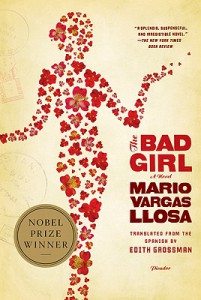
The Bad Girl by Mario Vargas Llosa (Macmillan, 2008), translated by Edith Grossman
Travesuras de la niña mala (Alfaguara, 2006) by Peruvian Nobel Laureate Mario Vargas Llosa narrates an unrequited obsessive love story between a translator-interpreter and a femme fatal à la Flaubert’s Madam Bovary. His almost pathological infatuation begins in his native Peru when as a teenager he meets a Chilean girl, and grows to become an international chase for her, a character who appears and reappears in many guises “morphing from guerrilla fighter, to kept woman of a Parisian diplomat, to English society maven, Yakuza gangster moll, middle class housewife, and, finally, terminal cancer patient” (Brendan Hughes). The sense of homelessness in these uprooted characters in exile is reinforced by the protagonist’s work as a translator, which although it enables his cosmopolitan lifestyle, it also forces him to live always in the in-between, always as a foreigner. Being a translator is a way “of being present without being present, of existing but not existing,” he says.
With a nostalgic depiction of Paris and Latin American political turmoil as backdrop, this novel features all the recurrent literary themes of the Boom era. Even the couple’s fortuitous and improbable encounters around the globe could only be explained by magic!
Edith Grossman, the novel’s translator, is one of the most important literary translators today and is responsible for bringing into English Latin American and Spanish authors from Nobel Laureate García Márquez to Augusto Monterroso and Álvaro Mutis, and last but definitely not least, Miguel de Cervantes himself. From Vargas Llosa, she has translated some other six novels, including one of his most acclaimed ones, La Fiesta del Chivo / The Feast of the Goat (2001).
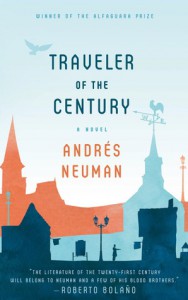
The Traveler of the Century by Andrés Neuman (Pushkin Press, 2012 / Farrar, Straus and Giroux, 2013), translated by Nick Caistor and Lorenza García
It’s hard to summarize an almost six-hundred-page novel into a one liner. Reviews of El viajero del siglo (Alfaguara, 2009) have called it a novel of ideas, a love story, a total novel, and also a “genre-bending, unpredictable and omnivorous monster of a work” (Juan Gabriel Vásquez). It’s about the itinerant adventurer and literary translator Hans, who arrives at the fictitious and enigmatic Wandenburg, a German town of an uncanny and elusive geography, where streets seem to rearrange themselves overnight, making it extremely hard to leave. Having met the betrothed and stunning Sophie there doesn’t make it any easier either. It’s also about an eclectic cast of minor characters which include a nameless organ grinder, a nostalgic Spanish émigré, and a literary salon full of aristocrats. Finally, it is about the predicament that marked nineteenth-century Europe, and that is still as relevant in our globalized world today, between cosmopolitanism and nationalism; a debate that can also be said to be ever-present in translation. The Traveler of the Century is, above all thus, a novel about translation; its shortcomings, challenges, and possibilities.
“Translation is the most intimate act of reading” says Spivak, and this rings true for Hans and Sophie who furtively undertake the enormous and ambitious project of translating European poetry together. Soon, translation becomes a metaphor for their rather explicit lovemaking: “Thus, inadvertently, they [Sophie and Hans] developed a shared language, rewriting what they read, translating one another mutually. The more they worked together, the more similarities they discovered between love and translation, understanding a person and translating a text, retelling a poem in a different language and putting into words what the other was feeling,” Neuman writes.
The first of his books to be translated into English, The Traveler of the Century is Neuman’s fourth novel and it has already been translated into a dozen languages. For Nick Caistor and Lorenza García, translating this novel must have been an enterprise, by no means less enormous and ambitious than Hans and Sophie’s undertaking. Their final product has been called an “exquisite” and “magnificent” rendering, and named “a very close contender” for the 2013 Independent Foreign Fiction Prize. The translation scenes featured within the novel “create a feeling of the possibilities of communication and understanding across frontiers. And that’s what we’re trying to do in our own small way as translators,” they said in an interview.
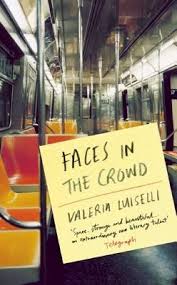
Faces in the Crowd by Valeria Luiselli (Coffee House Press, 2014), translated by Christina MacSweeney
A ghost story or, rather, a story of ghosts, Mexican-born writer Valeria Luiselli’s debut novel Los ingrávidos (Sexto Piso, 2011) offers a scaffolding, unnervingly fragmented three-dimensional reading experience, one in which the lines between fiction and reality become blurred and the narrative voices intertwined. It tells, at least, three stories: a mother in Mexico writes a novel in which she reminisces about what might or might not have been her own younger self as a translator in New York, a young female translator works in a Harlem small publishing house dedicated to literature in translation who when tasked with finding “the next Bolaño” becomes obsessed with little-known Mexican writer Gilberto Owen, and the ill-fated poet Gilberto Owen himself, whose time in New York during the Harlem Renaissance coincided with that of Lorca’s and Pound’s, and whose life there has been imagined by the mother in Mexico and appropriated and fictionalized by the young translator, who starts writing as if she were him in an attempt to have him published, even if in her words. Soon, she becomes haunted by his ghost, who she sees in the subway, just as much as her story haunts the mother writer in Mexico, the narrator who arranges and rearranges the novel’s structure: “I know I need to generate a structure full of holes so that I can always find a place for myself on the page, inhabit it; I have to remember never to put in more than is necessary, never overlay, never furnish or adorn. Open doors, windows. Raise walls and demolish them,” she writes.
Readers might quickly notice the difference between the original title, which translates as “weightless” and the English title, a line from Pound’s poem ‘In a Station of the Metro’: “The apparition of these faces in the crowd: Petals on a wet, black bough.” This is just one example of the creative freedom that has guided the inventive collaboration between Luiselli and her translator, Christina MacSweeney, who has already translated three works by the author and who in her latest, The Story of My Teeth, has even included a chapter of her own making, rendering her translation a true new original. Faces in the Crowd was long-listed for the 2015 Best Translated Book Award (BTBA) and the runner-up to the 2014 World Cup of Literature Championship Game.
As treachery, subversion, cosmopolitanism, love metaphor, and ghostly presence, translation in these novels becomes symptomatic of our current world and yet only represents a mere fraction of the role the fictionalization of translators continues to play in contemporary Latin American and Spanish literature. There are dozens of works on translators to look forward to in translation still. An exciting confirmed one is Include Me Out (Inclúyanme fuera) by Argentine writer María Sonia Cristoff, coming soon in 2019 by Transit Books and translated by Katherine Silver. It’s about an interpreter who is sick of her job and retires to a god forsaken town with the premise of remaining in complete silence for a whole year. Translation here becomes the casualty of a failed globalization project. Stay tuned!
Denise Kripper is a literary translator from Buenos Aires, Argentina. She holds a PhD in Literature and Cultural Studies from Georgetown University, and she’s currently Assistant Professor of Latin American Literature and Translation at Lake Forest College near Chicago.
*****
Read more about foregrounding the act of translation from the blog:

